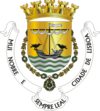Lisbon
![]()
The title of this article is ambiguous. For other meanings, see Lisbon (disambiguation).
Lisbon (Portuguese Lisboa [liʒˈβoɐ]) is the capital of Portugal as well as of the eponymous national government district of Lisbon, it is one of the larger cities in the European Union with nearly 600,000 inhabitants as well as 2.8 million inhabitants in the Lisbon metropolitan area (as of 2019). The Lisbon district has 2,963,272 inhabitants, the metropolis is located on a bay of the Tagus River estuary in the extreme southwest of Europe on the Atlantic coast of the Iberian Peninsula. Outside the city of Lisbon, a series of beaches stretch along the Atlantic Ocean between Cascais and Estoril.
The commercial port on the bay of the Tagus was called Ubbo before the Roman rule of Alis. Lisbon, a foundation of the Phoenicians, received Roman city rights in the time of Julius Caesar under the name Colonia Felicitas Iulia. In 711, like most of the Iberian Peninsula, the city fell to the Moors; in the context of the Second Crusade, Lisbon became Portuguese in 1147 and thus returned to Christian rule. After the transfer of the royal seat from Coimbra, the city became the capital of the Kingdom of Portugal in 1256 under King Afonso III. Around 1500, Lisbon experienced a brilliant rise to become one of the most glamorous trading and port cities of the time.
In 1755, a massive earthquake sealed the city's economic decline, which had already begun creeping decades earlier, and caused a sensation throughout Europe. In the 19th century, Lisbon experienced a resurgence.
Since the last quarter of the 20th century, however, the city has shrunk massively (from over 800,000 inhabitants around 1980 to about 500,000 around 2017); many people have moved to the surrounding countryside. Lisbon has to contend with considerable structural problems, among which the dilapidated fabric of many buildings and the enormous road traffic stand out. However, large and small infrastructure projects have already begun to modernize the city, as evidenced by housing construction and renovation programs, as well as a growing network of bicycle paths and expansion of public transportation. In 2020, Lisbon was named the European Capital of the Environment. The city has also become important as an IT location, with a growing number of start-up companies, IT development departments of international companies, and, since 2016, as the host of the Web Summit, an important international technology meeting.
Still the largest city in Portugal, with the main port, the seat of government, the highest state and government agencies, several universities and the Academy of Sciences (Academia das Ciências de Lisboa), the city is now the political, economic and cultural center of the country. In 1994, Lisbon was the European Capital of Culture; Expo 98, the 1998 World's Fair, was held here; and with the Hieronymite Monastery and the Torre de Belém, the city is home to UNESCO World Heritage Sites (entry 1983). Fado, which is indigenous here, has also been a UNESCO-protected intangible cultural heritage site since 2011. Numerous major international events have been and are frequently held in Lisbon, including the 2018 Eurovision Song Contest, the 2005 MTV Europe Music Awards, seven Rock in Rio festivals, or soccer finals such as that of the 2004 European Football Championship, the 2005 UEFA Cup, and the 2014 and 2020 UEFA Champions League finals, among a host of other cultural and sporting events. Since the 2010s in particular, a number of internationally renowned personalities have moved to Lisbon, especially actors, musicians and athletes. This further increased the city's growing appeal to tourists. Meanwhile, cruise ships call at the city frequently. The city won several international destination awards, such as the World Travel Awards in categories such as best city break destination (2019) or best cruise destination (2020), among others.
The place is home to several European Union agencies, including the European Monitoring Center for Drugs and Drug Addiction and the European Maritime Safety Agency. The Community of Portuguese Speaking Countries (CPLP) also has its headquarters in Lisbon.
Lisbon is considered the safest capital in Europe.
Geography
The Lisbon metropolitan area corresponds to the Lisbon district and covers 84.7 km² with 506,654 inhabitants (as of 2018). Lisbon District is home to approximately 2,400,000 people (as of 2015), and the Lisbon Metropolitan Region is home to 3,200,414 people (as of 2015), more than 30% of the Portuguese population. The metropolitan region covers Grande Lisboa on the northern bank of the Tagus River and the Península de Setúbal in the south.
Geographical position
Lisbon is located on the Iberian Peninsula. The city is located on a bay on the northern shore of the mouth of the Tagus River in the extreme southwest of Europe on the Atlantic coast. The Tagus, which widens shortly before its mouth, narrows in the last kilometers to the Atlantic. There the city stretches along the shore. From the shore, it rises in steps up several hills. In Lisbon there are high hills and deep valleys. The highest elevation in the urban area reaches 226 meters. For a long time, the city developed only along the Tagus River. Since the 20th century, the capital has been steadily spreading inland.
Geology
The city is situated on seven hills, not counting the smaller elevations. In the Atlantic Ocean at the level of Cádiz, a tectonic fault runs in an east-westerly direction, the so-called Gloria sheet fault. Two other tectonic features, the Gorringe Bank and the Marquês de Pombal Fault, are located at the level of Portugal's southern coast. Earthquakes are a consequence of the collision of the northward drifting African plate with the Iberian Peninsula (Eurasian plate). Furthermore, numerous active mud volcanoes in the Gulf of Cadiz indicate ongoing seismic activity in the region. Due to past earthquakes, observation points were established on the seafloor in 2004. They are designed to measure temperature and pressure variations that indicate stresses in the earth's crust that can be discharged in an earthquake.
Climate
The climate classification according to Lauer and Frankenberg (1987) assigns the climate of Portugal to the maritime and semihumid climate of the subtropical climate zone. Due to its location directly on the Atlantic Ocean, it is characterized by the temperature behavior of the sea: Not too hot summers and relatively mild winters. Temperatures rarely fall below 0 °C. Snowfall is even rarer.
| Lisbon | ||||||||||||||||||||||||||||||||||||||||||||||||
| Climate diagram | ||||||||||||||||||||||||||||||||||||||||||||||||
| ||||||||||||||||||||||||||||||||||||||||||||||||
| Monthly average temperatures and precipitation for Lisbon
Source: wetterkontor.de | ||||||||||||||||||||||||||||||||||||||||||||||||||||||||||||||||||||||||||||||||||||||||||||||||||||||||||||||||||||||||||||||||||||||||||||||||||||||||||||||||||||||||||||||||||||||||||||||||||||||||||||||||||||||||||||||||||||||||||||||||||||||||||||||||||||||||||||||||||||||||||
The months with the highest rainfall are October to March. A decisive factor is the location on the cool Canary Current, which sweeps along the coast of Portugal in a southerly direction. It often causes coastal fog during the warm season. In winter, Lisbon lies in the sphere of influence of Atlantic low pressure systems, which bring a lot of rain to the coastal area. The average annual precipitation is 656 mm.
Etymology
There are different explanations for the origin of the name. Lisbon was called Olissipona or Olisibona by the Goths and Romans. The folk etymology sees in it a connection with the hero Odysseus. Under Julius Caesar, the place belonging to the province of Lusitania was called Felicitas Julia. Others derive the name Lisbon from the Phoenician Alis ubbo. Another theory explains the name creation with the pre-Roman names of the river Tagus, "Lisse" or "Lucio".
The name Lisbon is usually abbreviated as "LX" or "Lx", which goes back to the antiquated spelling "Lixbõa". While the old spelling has now completely disappeared from usage and violates modern language standards, the abbreviation is still frequently used.
City breakdown
Until 2013, Lisbon was divided into 53 municipalities, which in turn were assigned to four districts (bairros) for administrative reasons.
|
|
|
After a long public debate, the Portuguese Parliament passed Law No. 56/2012 on November 8, 2012, reorganizing the municipalities of Lisbon. The territorial reform in Portugal came into force the following year. Since 2013, Lisbon has been divided into 24 urban municipalities (freguesias):
| Community | Inhabitants | Area | Density | LAU code |
| Ajuda | 15.617 | 2,88 | 5.429 | 110601 |
| Alcântara | 13.943 | 5,07 | 2.747 | 110602 |
| Alvalade | 31.813 | 5,34 | 5.956 | 110654 |
| Areeiro | 20.131 | 1,74 | 11.551 | 110655 |
| Arroios | 31.653 | 2,13 | 14.876 | 110656 |
| Avenidas Novas | 21.625 | 2,99 | 7.222 | 110657 |
| Beato | 12.737 | 2,46 | 5.178 | 110607 |
| Belém | 16.528 | 10,43 | 1.585 | 110658 |
| Benfica | 36.985 | 8,03 | 4.609 | 110608 |
| Campo de Ourique | 22.120 | 1,65 | 13.395 | 110659 |
| Campolide | 15.460 | 2,77 | 5.573 | 110610 |
| Carnide | 19.218 | 3,69 | 5.209 | 110611 |
| Estrela | 20.128 | 4,60 | 4.372 | 110660 |
| Lumiar | 45.605 | 6,57 | 6.936 | 110618 |
| Marvila | 37.793 | 7,12 | 5.306 | 110621 |
| Misericórdia | 13.044 | 2,19 | 5.950 | 110661 |
| Olivais | 33.788 | 8,09 | 4.178 | 110633 |
| Parque das Nações | 21.025 | 5,43 | 3.868 | 110662 |
| Penha de França | 27.967 | 2,71 | 10.317 | 110663 |
| Santa Clara | 22.480 | 3,36 | 6.699 | 110664 |
| Santa Maria Maior | 12.822 | 3,01 | 4.258 | 110665 |
| São Domingos de Benfica | 33.043 | 4,29 | 7.695 | 110639 |
| São Vicente | 15.339 | 1,99 | 7.724 | 110667 |
| Santo António | 11.836 | 1,49 | 7.921 | 110666 |
| Lisbon circle | 552.700 | 100,03 | 5.525 | 1106 |

enlarge and show information about the image
![]()
Lisbon: panoramic picture

Lisbon: View from São Jorge Castle
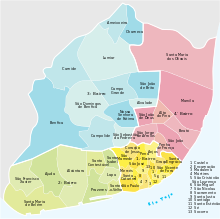
Map with the former 53 municipalities (freguesias) and 4 districts (bairros)

Map with the current 24 municipalities (freguesias) in 5 zones (UIT - Unidades de Intervenção Territorial).
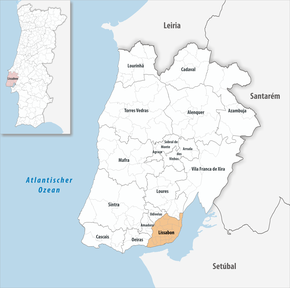
Lisbon circle
Population
Population development
The population of the city proper is 499,700 (as of 2007); the population for the Lisbon metropolitan area is approximately 2,800,000, according to the Instituto Nacional de Estatística ("National Institute of Statistics"). The population density of the city proper is 6,658 inhabitants per km². In 2007, 13% of the population was under 15 years old and 24% over 65. In contrast, the national average for Portugal was only 17% for those over 65. Women make up more than half of Lisbon's population at 54%.
Over the past 30 years, Lisbon has experienced a dramatic population decline. Despite an influx of 53,000 people between 1996 and 2001, two more left the city in 2001 for every new resident who moved to Lisbon. The newcomers are primarily families whose financial resources enable them to pay for the high cost of housing; younger people and representatives of the middle class in particular, on the other hand, have moved away. The tendency toward suburbanization that can be observed in the city is counteracted by the successive relocation of housing to the metropolitan area of Lisbon: This massively increases the number of commuters, so that mobility and transportation problems have now become a critical factor in the city's daily life and in terms of the quality of life of its citizens.
Population development of Lisbon (1801-2007)
|
|
|
|
Religion
See also: List of the Patriarchs of Lisbon
The majority of Lisboners profess the Roman Catholic faith. According to a 2018 survey, just over half of Lisbon's population reported being Catholic (54.9%) and 35% reported having no religion (including 13.1% believers with no affiliation to a religious community, 10% atheists, 4.9% indifferent, and 6.9% agnostic). 10% of the population reported belonging to smaller religious communities, with half (5%) indicating Protestant church and the other 5% distributed among Jehovah's Witnesses, Muslims, Buddhists, Orthodox and others. Only 11.4% of the Lisbon population reported weekly attendance at a church or other place of worship.
In addition to its demographic presence, the Roman Catholic Church is also historically present in the city: the first bishopric of Lisbon was founded as early as the 4th century. When the city was conquered by the Moors, it continued to exist as a partially vacant titular bishopric of the Roman Catholic Church. In addition, there is evidence of Mozarabic bishops of Lisbon, whose names are not known. After the reconquest by Alfonso I, it revived as a Roman Catholic bishopric under its bishop, the Norman Gilbert of Hastings (bishop from 1147 to 1166). This period also saw the beginning of the construction of the cathedral church Igreja de Santa Maria Maior, on the former site of a mosque, now considered the oldest church in the city. Finally, in 1716, the Patriarchate of Lisbon was established. After the European Youth Meeting in 2004/2005, Lisbon will host another major church event in 2023 with the 24th World Youth Day.
The Cemitério Alemão cemetery of the German community is located in the municipality of Santo Condestável.
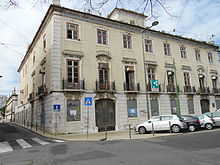
Vacant building in the city center
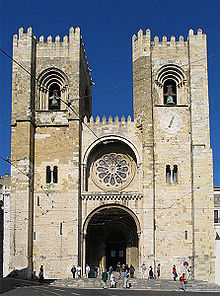
Catedral Sé Patriarcal
Local Politics
City Council and Municipal Council
The municipal and local assemblies are elected by the residents on the basis of proportional representation. The directly elected city council and the municipal council constitute the local state authority. They are responsible to the respective assembly. Local self-government is financed by local revenues and own resources as well as by the state financial equalization. The budget is prepared by the municipal or city council and submitted to the respective assembly for decision. In the Lisbon metropolitan area, revenues of 40 to 50 percent, from real estate tax and motor vehicle and business tax, have contributed to the local budget in recent years.
The Cámara Municipal (engl. City Council) consists of 17 and the Assembleia Municipal (engl. Municipal Council) of 107 members. The members of the municipal council are elected by the municipal assembly. The municipal council is chaired by the candidate on the first list position of the strongest local party. The mayor is appointed by the party with the highest share of seats in the municipal council.
The local elections held on October 9, 2005, produced the following results:
| City/County Council | PSD | PS | PCP | BE | PP | PEV |
| Cámara Municipal | 8 | 5 | 2 | 1 | 1 | 0 |
| Assembleia Municipal | 56 | 28 | 13 | 5 | 3 | 2 |
Local elections in the period from 2007 to 2017 produced the following results:
| City Council (Cámara Municipal), 2007-2017 | ||||||||||||||
| Year | PCP | PS | PSD | CDS | PPM | UDP | APU | AD | CDU | BE | CR | HR | PAN | |
| 2007 | 9.5 | 29.5 | 15.7 | 3.7 | 0.4 | - | - | - | 9.5 | 6.8 | 16.7 | 10.2 | - | |
| 2009 | - | 44.0 | 38.7 | - | - | - | 8.1 | 4.6 | - | - | - | |||
| 2013 | - | 50.9 | 22.4 | 1.2 | - | - | - | 9.9 | 4.6 | - | - | 2.3 | ||
| 2017 | - | 42.0 | 11.2 | 20.6 | - | - | - | 9.6 | 7.1 | - | - | 3.0 | ||
| Source: Comissão Nacional de Eleições | ||||||||||||||
Mayor
See also: List of Mayors of Lisbon
In May 2007, early local elections were necessary because the Lisbon mayor at the time, Carmona Rodrigues, had to resign due to a corruption scandal. In the election on July 15, 2007, Lisboners elected António Luís Santos da Costa as mayor of the Portuguese capital with a simple majority of 29.54 percent. Voter turnout was 37.39 percent. On April 6, 2015, Lisboners elected Fernando Medina as the new mayor of Lisbon.
Coat of arms
|
| Logo: "In wave cut divided by gold and green, below three silver wave beams after the division, growing out of it a black single-masted sailing ship with silver, left waving mast flag with double swivel and furled silver square sail, on the ends of the ship each a black bird, facing each other (raven and crow). Above the coat of arms a black-grooved golden mural crown, below four black round portals, above five attached tin towers, in each a black portal, surmounted by two black windows, under the shield a white band with the three-part motto in black majuscules: "MUI NOBRE E - SEMPRE LEAL - CIDADE DE LISBOA" (engl. Very noble and always faithful city of Lisbon). The lower shield is surrounded by the chain to the attached Order of the Tower and Sword." |
| Coat of arms justification: The escutcheon of Lisbon is adorned by a sailing ship with two ravens. The image refers to a legend. Supposedly, the body of the city's patron saint, Vicente de Saragoça, was propelled in a runaway boat accompanied by a raven and a crow on the Algarve coast, at Cabo de São Vicente. From this place the body was brought to Lisbon and buried there. The city was awarded the Order of the Tower and the Sword. |
See also: List of coats of arms in Lisbon
Twin cities
Lisbon is twinned with the following cities:
|
|
|
|
Culture and sights
Cityscape
Today's cityscape of Lisbon goes back mainly to building measures from the 18th century onwards. The center of Lisbon is the Baixa. The old town impresses with its tile facades and medieval narrow streets. In the inner city neighborhoods, problems with building fabric also characterize the cityscape. In 1994, the total number of buildings in Lisbon was given as 62,041. Of these, 30.73% of the buildings dated from before 1919 and 21.37% from between 1919 and 1945. According to surveys conducted by the Center for Territorial Studies of the City of Lisbon in 1992, one-third of the estimated renovation costs of existing housing fell on buildings between 1850 and 1930.
Due to a ban on raising rents, many property owners stopped investing in their property since the late 1960s, as inflation meant that rental income no longer covered maintenance costs. As a result, thousands of houses in Lisbon fell into disrepair. It was only as part of the reform program to overcome Portugal's economic crisis that this law was repealed in 2012. As a result, tens of thousands of apartments were renovated; the removal of rent control resulted in the gentrification of entire neighborhoods.
UNESCO World Heritage
In 1983, the Torre de Belém and the Mosteiro dos Jerónimos (Jerome Monastery) were declared World Heritage Sites by UNESCO. The Torre de Belém, located in the eponymous district at the mouth of the Tagus River, is one of Lisbon's most famous landmarks. The watchtower was destroyed during the Napoleonic invasion and reconstructed in 1846. Along with the nearby Mosteiro dos Jerónimos, it is one of the few outstanding structures of the "Manueline style" that survived the Lisbon earthquake. The Mosteiro dos Jerónimos is located in the Belém district. In addition to the royal tombs, the tomb of the famous navigator Vasco da Gama is also located here. The monastery is considered the most important building of the Manueline style, a Portuguese variant of the late Gothic style, which also contains some elements of the Renaissance.
Buildings
Sacral buildings
The monastery of São Vicente de Fora is one of Lisbon's most interesting buildings. It was founded in 1147 as an Augustinian monastery by Alfonso I outside the city walls and dedicated to St. Vincent of Saragossa. During the reign of Philip II, the church and the monastery acquired the present appearance. Many family members of the Portuguese royal family from the House of Braganza were buried in the church.
The Castelo de São Jorge, a fortress complex with integrated castle ruins, was used as a royal castle for centuries. One of the castle's towers, the Torre do Tombo, housed the royal document collection. The castle was largely destroyed in the great earthquake of 1755. After extensive renovation work, the complex is once again in good condition.
The main church of the city of Lisbon and the cathedral of the Patriarchate of Lisbon is the Catedral Sé Patriarcal. Construction on the oldest church in the city began in 1147, and an earthquake damaged the structure in 1344. In 1380, the western facade was built in the Romanesque style.
In the 17th century, the large baroque church Igreja de Santa Engrácia (Engl. Church of St. Engrácia) was built. The church was not completed until the 20th century. It was never used as a place of worship and today serves as the Panteão Nacional (engl. National Pantheon). Several state presidents and writers have been buried in the building, as well as, most recently, soccer idol Eusébio. In addition, there are still some cenotaphs for "heroes of Portuguese history".
The Convento do Carmo is a monastery of the Carmelite Order built between 1389 and 1423 by Nuno Álvares Pereira. The Carmelite church was considered a splendid example of Lisbon Gothic. The monastery was severely destroyed by the earthquake of 1755. Today, only the ruins can be visited.
The synagogue in the style of historicism was built in 1902-1904.
Technical buildings
The Aqueduto das Águas Livres has a length of 19 km and extends from Queluz via Caneças to the Mãe d'Água das Amoreiras. This aqueduct is one of the largest structures of its kind in the world. The most imposing is the aqueduct in the Alcântara Valley. The arched bridge has a total length of 941 meters. The 66 m high bridge is supported by 109 arches.
The Elevador de Santa Justa, also known as the Elevador do Carmo, is a 45-meter-high passenger elevator that connects the Baixa district with the higher Chiado district in downtown Lisbon. In common parlance, Lisbon's three tram-like funiculars are sometimes called elevador, which is actually a vertically moving elevator.
Representative buildings
The Palácio de São Bento was initially a Benedictine monastery. It was built in 1598. The Benedictine monks lived in the monastery until 1820. In 1834 the Portuguese Parliament moved into the building. In the rear part of the building is the seat of the Prime Minister.
The Portuguese Foreign Minister is housed in the Palácio das Necessidades the former royal palace from the 18th century. The palace became the official residence of the royal family during the reign of Queen Maria II. After the proclamation of the Republic on October 5, 1910, the building was designated the seat of the Ministry of Foreign Affairs.
The Palacete Lambertini is a former city villa in the city center.
António José Dias da Silva, a Portuguese architect, designed the Praça de Touros do Campo Pequeno (Eng: Bullring) at Campo Pequeno. The arena was built between 1890 and 1892, after the demolition of the former Lisbon bullring at Campo de Santana, which was in operation between 1831 and 1891.
Monuments
The Padrão dos Descobrimentos Monument to the Discoverers is located in the Bélem district on the banks of the Tagus River. It was erected in 1960 under the Salazar regime, exactly 500 years after the death of Henry the Navigator, and is intended to glorify the old times of the seafaring nation of Portugal. It depicts the prow of a caravel, on which, led by Henry the Navigator, other important people from the Age of Discoveries are represented. The tower, 54 meters high, with stylized sails on the sides, symbolizes the mast of the caravel.
The Torre Vasco da Gama is a 145-meter-high steel truss observation tower built in 1998 for the World's Fair. According to plans by Portuguese architect Nuno Leónidas, the Vasco da Gama Tower is to be converted into a luxury hotel with 178 rooms on 20 floors. The conversion was from 2007 to 2012 and is now called MyRiad. The Oceanário de Lisboa also stands in the area of the former Expo 98 exhibition site. It is the second largest oceanarium in the world and is located there in the Park of Nations.
The 113 m high Cristo Rei (Almada) statue of Christ, erected in 1959, is located on the southern side of the Tagus River, but is considered a landmark of Lisbon.
Expo 98
The World Expo 98 was held in Lisbon from May 22 to September 30, 1998. It was the first to be held in Portugal and the fourth of five so far on the Iberian Peninsula (1888 Barcelona, 1929 Barcelona, 1992 Seville, 2008 Zaragoza) and was held under the motto "Os oceanos: um património para o futuro", in German "The oceans: a heritage for the future". The Expo was attended by 143 countries and 14 international organizations. During the 132 opening days, 10.12 million people visited the 340-hectare World Expo. Today, the popular exhibition site is marketed under the name Parque das Nações.
Parks
Parque Florestal de Monsanto is the largest park in Lisbon. It is located in the west of the city and covers 800 hectares. It was first laid out in the 1930s. The largest park in the city center, on the other hand, is the Parque Eduardo VII at the upper end of the boulevard Avenida da Liberdade in the municipality of Avenidas Novas. The park was named after the British King Edward VII, who visited Portugal in 1903. The third largest park in the city is the Jardim da Estrela, built in 1852 and located opposite the Basilica da Estrela. Officially it is now called Jardim Guerra Junqueiro, but in everyday life it continues to be called Jardim da Estrela. The Jardim do Campo Grande, in German "Garden of the Great Field", is a park of over 12.5 hectares in the municipality of Campo Grande. Also in the north of Lisbon is the 11-hectare Parque Botânico do Monteiro-Mor, which was created as early as the second half of the 18th century.
Streets, places
The Avenida da Liberdade is a boulevard in Lisbon modeled on the Avenue des Champs-Élysées in Paris. It connects the Baixa (lower city), built after the earthquake of 1755, with the higher-lying neighborhoods in the north and was continued in the Avenidas Novas from the beginning of the 20th century. A first section of the Avenida was inaugurated in 1882, on the 100th anniversary of the death of Marquês de Pombal and the circular square dedicated to him.
Miradouro" in Portuguese generally refers to a viewpoint. The miradouros are among the most beautiful places in the city. They are located on the hills all around and offer views of the old town or the Tagus River.
Bairro Alto (Upper Town) is a district of Lisbon located above the Baixa business district. It is best known for its nightlife. Among the oldest and most famous cafes in the city is A Brasileira. Located in the Chiado district, the café was founded by Adriano Telles on November 19, 1905. It was a popular meeting place for intellectuals. Among others, the Portuguese poet Fernando Pessoa and the writer Aquilino Ribeiro frequented it. Since 1988, a bronze statue of Pessoa has stood in front of the café.
Museums
→ Main article: List of museums in Lisbon
There are numerous museums in Lisbon. The Museu Nacional de Arte Antiga (National Museum of Ancient Art) is one of the most important art museums in Portugal. A significant focus of the collection is works by Portuguese artists. It owns works by Hieronymus Bosch, Albrecht Dürer, Pieter Brueghel the Younger, Piero della Francesca, Hans Holbein the Elder and Raphael, among others. Between 1964 and 1969, the Museu Calouste Gulbenkian building was constructed. The permanent exhibition of the museum includes a wide range of art objects from all periods. In 1984 it was expanded to include the Museum of Modern Art. Among the most famous exhibits of the museum are the works of Rembrandt (Portrait of an Old Man), Claude Monet (Still Life with Melon) and Édouard Manet (The Soap Bubbles).
The Museu da Marinha (Marine Museum) is located in the Belém district. It is located in part of the west wing of the Mosteiro dos Jerónimos, together with the Museu Nacional de Arqueologia. The Museu de Etnologia (Ethnological Museum) has artifacts from all over the world. Most of them come from the former colonies. In 1904, the Museu Nacional dos Coches (Carriage Museum) was opened on the initiative of Queen Amalia. It houses a considerable collection of carriages. The oldest carriage on display is from the 16th century Spanish King Philip II. The Museu Colecção Berardo, opened by industrialist and art collector José Berardo in 2007, is housed in the Centro Cultural de Belém. The art collector has given the museum a considerable collection of modern and contemporary art of the 20th century from Europe and overseas.
Theater
In 1854 there were six theaters in Lisbon. Today, in addition to the state theaters, there are several independent festival houses that offer a rich program of performances. The Teatro Nacional D. Maria II (Eng: National Theater Dona Maria) is the oldest spoken theater in Lisbon and is centrally located on Rossio. Even older is the Lisbon Opera Teatro nacional de São Carlos, built in the late 18th century in the Chiado district. Right next to it is the municipal theater Teatro Municipal São Luiz. Also in Chiado is the Teatro da Trindade, built in the second half of the 19th century. Near the Praça de Espanha is the Teatro Aberto. In the Teatro Politeama, in the style of the 1920s, mainly hit musicals are performed. The ballet company Companhia Nacional de Bailado CBN moved into the Teatro Camões after the Expo. Other ballet companies also make guest appearances there. Other theaters include Teatro da Cornucópia, co-founded by Luís Miguel Cintra, Teatro da Comuna, Teatro Municipal Maria Matos, Teatro Taborda, Teatro Tívoli, Teatro Villaret, founded by Raul Solnado, and Teatro Vasco Santana.
Of historical rank was the Cinema Roxy. Cinema São Jorge is a premiere cinema in the city center that also hosts Lisbon's international film festivals, including Queer Lisboa, IndieLisboa, Doclisboa and Monstra. Another old cinema was the Animatógrafo do Rossio.
Music
Fado
→ Main article: Fado
The most internationally known of Lisbon's traditional music is fado, often sung with a wistful but also sometimes cheerful mood, and usually accompanied only by a classical guitar and a Portuguese guitar. Fado is performed in the evening, especially in bars in the Bairro Alto and Alfama districts. In addition to the traditional fado bars such as O Faia, Café Luso, Senhor Vinho, etc., the Clube de Fado, which opened only in 1995, has gained some importance in recent years. The name of Portugal's most popular fado singer, Amália Rodrigues, is particularly associated with fado internationally. As successor of the artist, who died in 1999, the singer Mariza is often mentioned internationally, but also such different names as Ana Moura, Mísia, Carminho or Cristina Branco have already achieved some international fame. Among the male singers, Alfredo Marceneiro, who died in 1982, is one of the most influential names in terms of style. Most recently, Carlos do Carmo, who died in 2021, was considered the most important contemporary singer, while Camané in particular has made a name for himself among the following generations.
Fado originated in the poor quarters of Lisbon, where it first appeared in the disreputable bars in the Mouraria district. Whether it originally developed from the songs of Portuguese sailors or originated from Brazilian musical styles such as lundum or modinha can no longer be determined beyond doubt from today's perspective. The Museu do Fado in the tradition-rich Alfama district is devoted in detail to the history of fado.
Since 2011, the fado is on the list of the intangible world cultural heritage of UNESCO.
Classic
The city's most important opera house is the Teatro Nacional de São Carlos, which opened in 1793. In addition, concerts and performances are held regularly in a number of other concert venues, such as the Centro Cultural de Belém. Among the city's most important orchestras are the Orquestra Metropolitana de Lisboa, the Orquestra Sinfonietta de Lisboa, the orchestra of the Gulbenkian Foundation, and the Orquestra do Conservatóro Nacional, the orchestra of the National Conservatory in Lisbon, now part of the ESTC.
Jazz, Rock and Co.
Lisbon is home to a variety of clubs, concert venues and bars of all stripes, including the Hot Clube de Portugal, the oldest jazz club still in existence in Europe. Thanks to its history as a metropolis of the Portuguese Empire, Lisbon is home to many African immigrants and therefore also a center of African music creation in Europe, with concert venues, bars and a multitude of musicians. In the internationally acclaimed sampler series of the New York Red Hot Organization, the CD Red Hot + Lisbon was released in 1998 to coincide with the Lisbon World's Fair. The CD is dedicated to these diverse musical influences in Lisbon.
The most diverse subcultures such as punk, gothic, rockabilly, heavy metal, hip-hop and many more are also present here. The concert club Rock Rendez-Vous played a special role in the development of the various subcultures in the 1980s and thus promoted the emergence of a multi-layered range of bands in the city.
→ See also: Lisbon bands and clubs overview
Bairro Alto in particular is transformed nightly into a lively nightlife district by its multitude of bars and clubs, but there are also a number of music venues for every taste in the old neighborhoods of Alfama and Mouraria, on the Cais do Sodré, or in the modern pub district in the former docks on the river in Alcântara, the Docas. The city's lively music scene also includes a number of music labels, such as the internationally renowned jazz label Clean Feed Records. With the Super Bock Super Rock, a major rock festival takes place in Lisbon, and the internationally renowned Rock in Rio festival has also stopped here several times.
Regular events
Since 1984, jazz lovers have met annually at the Gulbenkian Foundation's international jazz festival Jazz em Agosto in the Portuguese capital. The rock music festival Rock in Rio was held in Lisbon in 2006 and 2008. Also, among other regular fairs, an annual tourism fair is held at the FIL Fair.
The following Portuguese film festivals are held in Lisbon every year:
- Doclisboa - International Documentary Film Festival
- Queer Lisboa - the Festival of Gay and Lesbian Cinema (Festival de Cinema Gay e Lésbico de Lisboa)
- IndieLisboa - International Festival of Independent Film (Festival internacional de cinema independente)
- Monstra - international animated films
- Hola Lisboa - Iberian and Latin American Films (Festival de Cinema Ibero-Americano)
- MOTELx - Horror Films (Festival Internacional de Cinema de Terror de Lisboa)
- FESTin - Films of the Portuguese Language Area (Festival de Cinema Itinerante da Língua Portuguesa)
- PLAY - Films for children and young people
Annual tourism fair in the spring in Lisbon.
- Feira Internacional de Turismo
Feast celebrating the patron saint Anthony of Lisbon.
- Festas de Lisboa, also simply Santo António, annually on June 13 in the old town districts such as Alfama, Graça, Mouraria, Bica or Madragoa, and with large parades on the Avenida da Liberdade and other avenues
Flea Market:
- Feira da Ladra
Local recreation
The traditional seaside resorts of Cascais and Estoril are located in the surroundings of Lisbon. Estoril is considered a retreat for Lisbon's wealthy upper class and is located on the edge of the Estremadura. The place became famous because of its casino. Near Estoril is also the Autódromo, a race track where the Grand Prix of Portugal for motorcycles is held annually. The neighboring town of Cascais is located on a sandy bay of the Atlantic Ocean, about 25 kilometers west of Lisbon. From 1870, the royal family regularly spent summers in Cascais, which also attracted the aristocracy and upper middle classes to the town. The town has a marina with about 600 berths. The Serra da Arrábida Nature Reserve, in the Lisboa e Vale do Tejo region, extends west of Setúbal on the coastline away from the sea. There are a number of rare plants and animals there. The natural park covers an area of 10821 hectares on a strip up to 8 km wide and 22 km long along the coast. Its boundaries are the towns and villages of Sesimbra and Santana to the west, Azeitão and Quinta do Anjo to the north, and Palmela and Setúbal to the east.
Culinary specialties
In the countless pubs and restaurants and localities, dishes from international and local cuisine are served. However, there are few original Lisbon specialties that are not offered elsewhere. Portuguese cuisine is based on hearty and traditionally prepared dishes using meat, fish, vegetables, rice, beans and potatoes. Stockfish is both a specialty and a national dish of Portugal. There are also countless recipes for the salted and dried cod. Also popular are sardines, grilled as sardinhas assadas, as well as squid, lobster, crab, tuna, swordfish, eel, shrimp and other seafood. Ameijoas na cataplana, a mussel stew with pork, bacon and onions, is also typical. In addition to beef, goat meat (cabrito) and lamb (borrego) are often eaten in Portugal.
Internationally known is the Portuguese port wine, a liqueur wine, which is mainly drunk with desserts. Other specialties include the Pastel de Nata or Pastel de Belém. The custard tartlet - consisting of cake or puff pastry filled with creamy vanilla custard and dusted with cinnamon and powdered sugar - was probably made before the 18th century by monks of the Jerome Monastery in the Lisbon district of Santa Maria de Belém. After the secularization of the monasteries, the monks decided in 1837 to produce delicacies to be sold to Lisboners. Today, many locals and tourists visit the large cafeteria of the factory there to buy the pastéis. Only a few pastry chefs know the original recipe.
Lisbon on film
The city is the center of Portuguese cinema. Since the beginning of the art of film, however, it has itself been the subject of international and national film productions, whether as a documentary or a feature film. The focus is on the role of neutral Lisbon in the Second World War, the charm of its old neighborhoods, and its role in Portuguese culture, especially the fado and the writer Fernando Pessoa.
See also: List of movies related to Lisbon

Castelo de São Jorge

Palácio de São Bento
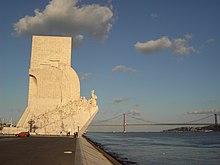
Padrão dos Descobrimentos
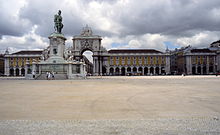
Praça do Comércio in Lisbon

Bronze statue of Fernando Pessoa in front of Café A Brasileira
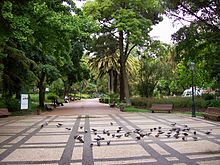
Park Jardim da Estrela

Oceanarium at Parque das Nações
.jpg)
Torre de Belém (construction period 1515-1521)
.jpg)
Mosteiro dos Jerónimos
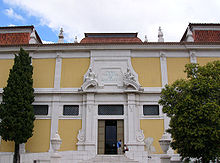
Museu Nacional de Arte Antiga
.jpg)
Fado Museum
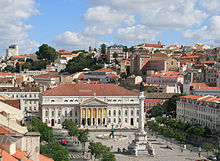
Teatro Nacional D. Maria II at Rossio
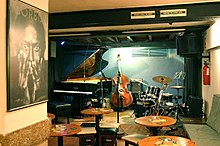
In Hot Clube de Portugal
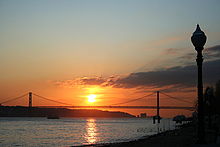
Ponte 25 de Abril
Sports
Lisbon has various sports facilities. The Estádio da Luz and the José Alvalade Stadium are the largest stadiums in the city. The city has hosted World and European Championships throughout its history.
World, European and national championships
Lisbon hosted the 1947 World Fencing Championships, the 1991 World Junior Football Championships, the 1999 European Short Track Championships, the 2001 World Indoor Athletics Championships, the 2001 UCI Road World Championships, the 2002 World Fencing Championships and the 2003 World Men's Handball Championships.
In the period from 1938 to 1945, the Portuguese Football Cup was held annually in Lisbon. Since 2004, Lisbon has hosted the European International Brazilian Jiu Jitsu Championships. In May 2014 and in August 2020, the Lisbon Estádio da Luz hosted the final of the UEFA Champions League.
Soccer
The soccer club Benfica Lisbon is the Portuguese record champion and won the European Cup of Champions in 1961 and 1962. The venue of the home games is the Estádio da Luz. The stadium, with a capacity of 65,000 spectators, hosted three group matches, a quarterfinal and the final of the 2004 European Football Championship. The stadium was completely rebuilt for the tournament.
Lisbon's Sporting Clube de Portugal (Sporting Lisbon) soccer club was the winner of the 1964 European Cup Winners' Cup. Sporting's soccer team plays its home games at the Estádio José Alvalade XXI. The 52,000-seat stadium was the venue for the 2004 European Football Championships. The stadium, which has been awarded five stars by UEFA, is located next to the old facility.
The Estádio do Restelo is the soccer stadium of the Belenenses Lisbon club and is located in the Belém district. The stadium was officially inaugurated on September 23, 1956 and holds around 32,500 spectators.
Other soccer clubs from Lisbon with a first division past are or were Atlético, Oriental, Casa Pia, Carcavelinhos and CF Unidos, which is now based in the suburb of Pontinha. In Greater Lisbon, Estrela Amadora, Estoril Praia and FC Alverca are or were first division, and from the cities on the opposite bank of the Tagus, Amora FC, Seixal F.C., Fabril Barreiro, FC Barreirense and C.D. Montijo.
Lisbon's most successful representative in national women's soccer is CF Benfica.
Other sports
Four clubs from Lisbon play in the LPA handball league: Sporting Clube de Portugal, Sport Lisboa e Benfica, Clube de Futebol Os Belenenses and Boa-Hora. In the basketball league UZO play the Lisbon clubs SL Benfica and União Lisboa. The Lisbon Half Marathon (pt. Meia Maratona de Lisboa) is one of the largest and most sporting half marathons in the world. It has been held in Lisbon since 1991, usually in March. The first Trans-European Race took place from April 19 to June 21, 2003 and led in 64 daily stages without a rest day from Lisbon to Moscow. At the end of December 2005, the Dakar Rally (formerly Paris-Dakar) began for the first time in the capital of Portugal.

José Alvalade Stadium
Economy and infrastructure
Economy
The Lisbon area is the most prosperous area in Portugal, with a GDP above the European average (Lisbon generates 45% of Portugal's GDP). In the Lisbon metropolitan area, 1,300,500 people are employed. The unemployment rate in the city was 8% in 2004. Lisbon's economy is based primarily on the service industry. Lisbon's seaport has great economic importance as an interface of land and sea transport, as a maritime service center and as an industrial location. In the Lisbon metropolitan region, the south bank of the Tagus River in particular is highly industrialized. 7 of the 10 largest listed companies in Portugal are based in Lisbon. These include Energias de Portugal, Portugal Telecom and Jerónimo Martins. The Lisbon Stock Exchange is part of the "multi-country exchange" Euronext with the stock exchanges in Amsterdam, Brussels and Paris.
In a 2018 ranking of cities by quality of life, Lisbon ranked 38th among 231 cities surveyed worldwide.
See also: Centro Comercial do Restelo
Road traffic
Due to its location on the Tagus River, for a long time Lisbon could only be reached directly from the south by ferry. The first bridge was built north of the city in 1951 at a narrow point of the river in Vila Franca de Xira to the north. The Ponte 25 de Abril (1013 m span and 2287 m length) was completed in 1966 and connected Lisbon with Almada on the south side of the Tagus for the first time. Since 1999, there has also been a rail link underneath the motorway. The A2 then leads further inland to the east or to Madrid/Spain. With the Ponte Vasco da Gama, one of the longest cable-stayed bridges in the world and the longest bridge in Europe, there has been a direct highway connection (A12/IP1) across the bay between Moscavide/Sacavém on the right and Montijo/Alcochete (Município)/Alcochete, or Setúbal with its industries on the left side of the Tagus since 1998.
To the north, the A8 freeway connects with Leiria, and the A1 runs along the coast to Porto, the country's second most important center.
Rail traffic
Along with Porto, the Portuguese capital is the main hub of the Portuguese rail network. Four rail lines run toward Lisbon, which - connected by the Linha de Cintura ring line - terminate at various stations in the Lisbon metropolitan area. The most important station is Santa Apolónia station on the Linha do Norte, where all international trains from Spain and France terminate, as well as the majority of the national high-speed Alfa Pendular trains. In addition, Oriente station is located in the northeast of Lisbon and will become the city's new main station in the future with the construction of the RAVE standard-gauge high-speed network. The two terminus stations Cais do Sodré (line to Cascais) and Rossio (line to Sintra) as well as the stations Sete Rios and Entrecampos on the Linha de Cintura remain for suburban traffic. Here also begins the line to the south side of the Tagus to Setúbal, operated by the private railroad company Fertagus.
Ferry service
There are several ferry connections across the Tagus to Barreiro, Cacilhas, Montijo, Porto Brandão, Seixal and Trafaria. Landings on the right side of the Tagus are: Belem, Cais do Sodré and Terreiro do Paço. The operator of all lines is now Transtejo & Soflusa, trademarked by the blue and white catamaran ferries, which at 30 knots have shortened the crossing on the Tagus to a third.
PUBLIC TRANSPORT
Public transport is mainly provided by the two companies Carris (Companhia dos Carris de Ferro de Lisboa) and the Metropolitano de Lisboa. Carris operates over 100 bus lines and six streetcar lines (12, 15, 18, 24, 25 and 28). Some of the streetcar services are operated with historic trolleys (pt. Eléctricos), such as on line 28. On December 15, 2018, one of the historic streetcars derailed in the Lapa district. The trolley was destroyed in the process, and 28 people were injured. It also operates four elevadores (engl. elevators) in the city, three of which are funiculars and one is a vertically moving elevator, the Elevador de Santa Justa. The three funiculars were built towards the end of the 19th century, when Lisbon began replacing the horse-drawn streetcars that had been operating since 1873 with cable streetcars from 1890 and later with electric streetcars. The Lisbon Metro comprises four lines, some of which extend beyond the city limits. The metro network, now 38 kilometers long, is being continuously expanded.
Airport
Lisbon-Portela International Airport is located six kilometers north of the city center and in the extension of the A12 freeway. The construction of the new Novo Aeroporto Lisboa airport has been under discussion for some time. On January 10, 2008, Prime Minister José Sócrates announced that it would be built on the Campo de Tiro Alcochete military site north of Alcochete. The Portuguese airlines TAP Portugal, White Airways, Portugália Airlines and EuroAtlantic Airways are based in Lisbon.
Port
The Port of Lisbon stretches for more than 10 km along the city's shoreline. There are also numerous facilities on the south side of the Tagus River in Trafaria, Porto Brandão, Almada, Seixal, Barreiro and Montijo, which belong to the Porto de Lisboa and are operated by the APL Port Authority, even though they are located outside the actual city area. These facilities specialize in grain and oil. On the other hand, the north side in Lisbon's urban area mainly handles containers. Here there are also direct connections to the train network in Alcântara and Santa Apolónia, where the city's two major container terminals are located. The largest and deepest docks are located in Alcântara. In total, the docks of the Port of Lisbon enclose a water area of 430,000 m². Cruise ships often dock in Lisbon to make a stop on their way from northern Europe to the Mediterranean, the Canary Islands or South America. For them, there are three docks at Gare Marítima de Alcântara, Rocha do Conde de Óbidos and Santa Apolónia. For private yachts, there are four moorings with the Doca de Alcântara, Doca de Santo Amaro and the Doca de Belém e Doca do Bom Sucesso. In total, there is room for about 1,100 ships here.

Streetcar 28
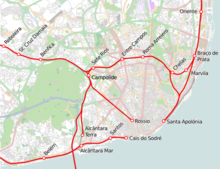
Routes served in passenger traffic
.jpg)
Lisbon Airport

Avenida Joaquim António de Aguiar, view from Praça do Marquês de Pombal

Oriente Station
.jpg)
Port

Ponte Vasco da Gama
Education and science
Lisbon has several universities and, along with Coimbra, is the most important university city in Portugal.
The University of Lisbon was founded in 1288 and confirmed by the Pope in 1290. It is one of the oldest universities in Europe, but was only reestablished in 1911 after a hiatus of more than 400 years. It is the largest university in Portugal, with over 47,000 students in eight faculties. Since 1991, the Arquivo Nacional da Torre do Tombo (Portuguese National Archives) has been located in a modern building on the university campus. The Lisbon Observatory (pt. Observatório Astronómico de Lisboa) was affiliated with the University of Lisbon in 1992 and integrated into the Faculty of Natural Sciences in 1995. As the largest hospital, the 1500-bed University Hospital de Santa Maria is also part of it. On December 31, 2012, the Technical University of Lisbon merged with the University of Lisbon to form the new University of Lisbon (Universidade de Lisboa).
The Catholic University of Portugal was founded in 1971 as a Catholic public educational institution in Lisbon. Over 11,000 students study in 18 faculties at several regional centers. In 1988, the state-owned distance learning university Universidade Aberta was established. In addition to its headquarters in Lisbon, it maintains two regional branches in Porto and Coimbra. In addition, there are 16 local study centers in Portugal and one in Mozambique. Other universities in Lisbon include the University of Lusíada, the Universidade Nova de Lisboa and the Autonomous University of Lisbon.
The German School Lisbon is the oldest German school on the Iberian Peninsula and the second oldest of all German schools abroad. It was founded in 1848 by a Protestant pastor of the German community in Lisbon. The school was forced to close during the First World War in 1916. It was reopened in 1922, but at the end of the Second World War the school was closed again. It was reopened on October 20, 1952.
The Portuguese National Library, founded in 1796, is located in the Campo Grande district of Lisbon. Attached to it is the Biblioteca da Ajuda, which goes back to the Royal Library (Biblioteca Real) and is housed in the Palácio Nacional da Ajuda.
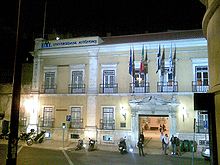
Autonomous University of Lisbon
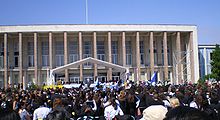
Lisbon University
Personalities
→ Main article: List of personalities of the city of Lisbon
Lisbon is the birthplace of many famous personalities. These include the poet Alcipe, the artist Helena Almeida, the UN Secretary General and former Portuguese Prime Minister António Guterres, the President of the European Commission José Manuel Barroso, the doctor and Pope John XXI, the singer Amália Rodrigues, and the former Prime Minister and President of the Republic Mário Soares.
In addition, a number of internationally famous personalities have moved to Lisbon, especially in the 2010s. The most famous names are likely to be pop musician Madonna, French fashion designer Christian Louboutin or former soccer player Éric Cantona, also actors such as German-Irish Michael Fassbender, Italian Monica Bellucci, US-American John Malkovich and a number of well-known Brazilian actors.
Former residents of Greater Lisbon also include Canadian musician Bryan Adams, Italian author Antonio Tabucchi, German historian Vera Leisner, and British photojournalist Joshua Benoliel.
Awards
The city of Lisbon was awarded the title of "European City of the Year 2012" by the London Academy of Urbanism in December 2011 and received the UNESCO award for Fado.
Search within the encyclopedia
